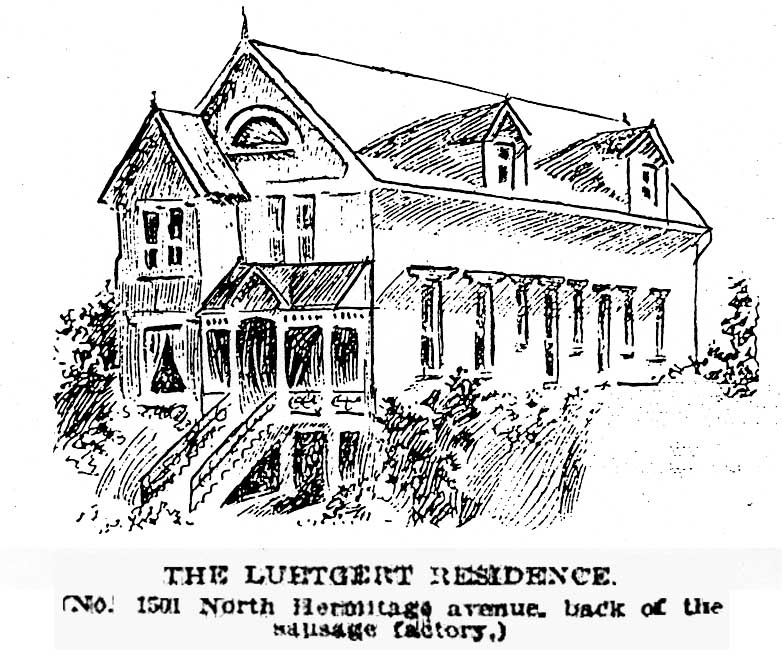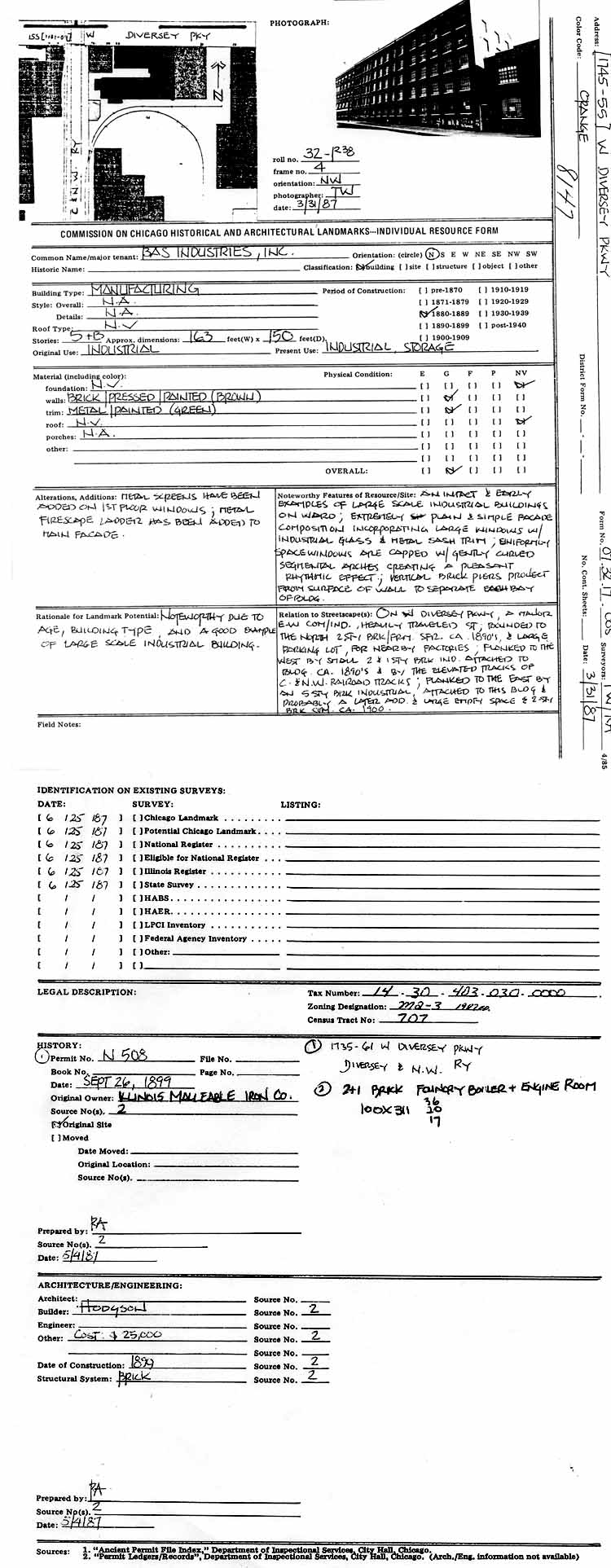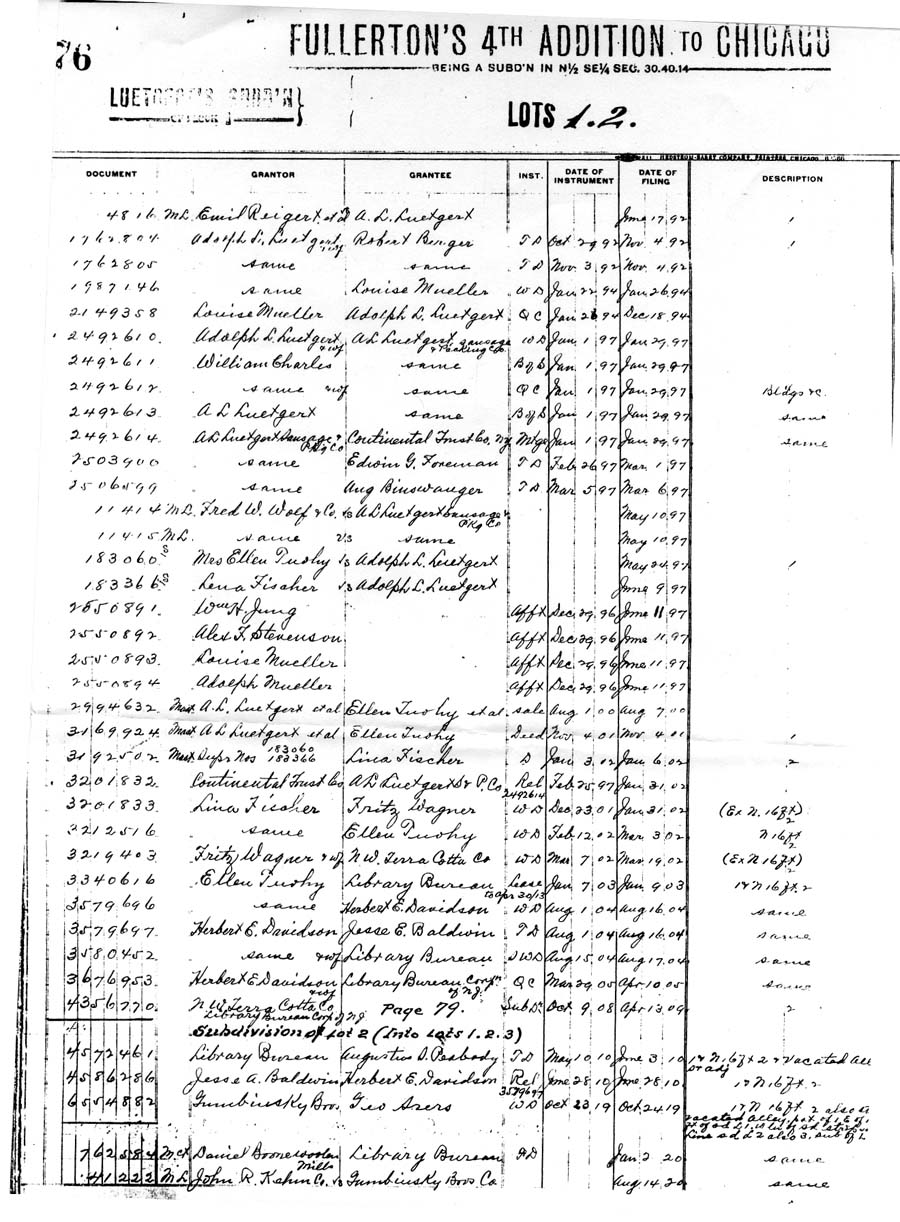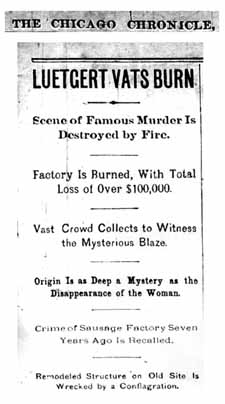
READ CHAPTER 1
GALLERY
WHO'S WHO
ATLAS
MYTHS DEBUNKED
FAMILY TREE
CONTACT THE AUTHOR
UPCOMING EVENTS
REVIEWS
CHICAGO HISTORY LINKS
READING SUGGESTIONS
BUY THIS BOOK
A Research Hunt: the Luetgert Factory Fire
When I began researching the story of Adolph Luetgert, I assumed that a fire had destroyed the sausage factory where Luetgert had allegedly dissolved his wife's body in a vat of potash.
After all, that is how the story was told in many of the articles written about the Luetgert case over the past few decades.
For example, a 1986 Chicago Tribune Magazine article on "The Sausage Factory Mystery" stated:
The sausage factory stood vacant for several years — haunted, it was said, by Louisa's ghost — its windows broken out by rocks thrown from the nearby railway embankment. Then one night in 1902 it caught fire, and all of the firemen with their horse-drawn pumpers could not save it.
A Halloween feature story published by the Chicago Sun-Times in 1982 told a similar tale, with additional details about the supposed ghost and the wanderings of the Luetgert house.
In 1897, the family's home was on Hermitage, just south of the factory on Diversey. It was moved at least once in the following years, and the Sun-Times article asserted that it "still stands on Diversey." If the house does still exist, its exact location is a mystery.
The Sun-Times article reports that Luetgert complained that his wife's ghost was visiting him in prison in Joliet — a tall tale that does not appear to be supported by articles from the time of Luetgert's incarceration. The article continues:
Apparently, the ghost made its way from Joliet to Chicago, because an apparition was reported inside the Luetgert house. Witnesses saw a silent, white-clad woman leaning against the mantelpiece. When tenants protested the house was haunted, it was moved to Mashfield Ave. between Wrightwood and Diversey.
Night watchmen then complained of an apparition in the sausage factory. When the factory burned down in 1902, the ghostly figure was seen again inside the former Luetgert residence.
Remodeled with new front and side porch, the house, a private residence, was moved back to Diversey. According to folklore, the ghost appears only on the anniversary of Louise Luetgert's death on May 1.

When I tracked down the author of the Sun-Times story, he understandably could not recall what sources he had used for his article some twenty years earlier, but he thought he had based the story on old newspaper clippings. Indeed, some of the Chicago neighborhood newspapers had run similar stories decades earlier, though it's hard to say what the original source was for the story about the ghost — or the 1902 fire.
A couple of years into my research on Alchemy of Bones, I met with Jim and M.J. Luetgert, two of Adolph and Louise Luetgert's great-grandchildren, to talk with them about the most infamous chapter in their family's history.
They casually mentioned that they had gone by the old sausage factory building recently and noticed it was being renovated.
I was dumbfounded. For a minute, I felt too stupid to say anything about it, but I finally said that I'd thought the factory had burned down. What were they talking about?
Oh, no, the Luetgert descendants told me. Don't believe those stories about the fire — the factory is still there, on the south side of Diversey just east of a railroad viaduct and a block west of Paulina.
I checked it out for myself, and sure enough, the five-story brick building at that location did look just like the one in the old newspaper drawings of the Luetgert factory.
Jim Luetgert erased any doubt that I might still have had when he e-mailed two pictures to me. One is an image of the old Luetgert factory inside a company paperweight that the family saved as a memento. The other is a photo Jim Luetgert took of the building currently at the site on Diversey. This photo was taken before the building was transformed into condominiums in the late 1990s, so it offers a clear view of the structure's architectural details.
Photos courtesy of Jim Luetgert.
Comparing these two images, it is clear that it is the same building. The pictures show the same number of windows and the same structural pattern. For further comparison, a drawing of the Luetgert factory, from the August 13, 1897, Chicago Daily News, is below.
It is worth noting here that it is something of a misnomer to call this building "the Luetgert factory." The sausage company actually had two connected buildings. As can be seen in the image from the paperweight, a smaller building was located behind the five-story structure. This was the factory where much of the sausage-making process took place.
The taller building along Diversey was a warehouse, but it also contained Luetgert's office, a grocery store and the infamous basement with sausage-curing vats, where authorities claimed Luetgert had committed the gruesome deed of boiling his wife's body. Click here to view a diagram of the Luetgert property and maps of the area.
The smaller building is no longer there, and the structure that used to stand on top of the five-story building near the east end is gone as well.
While the former Luetgert building was under renovation, I took a stroll around the neighborhood one day. There wasn't much to look at. The north side of Diversey had just a couple of decrepit old buildings, houses that looked as if they might have been around in Adolph Luetgert's day. They also looked as if they wouldn't last much longer. The rest of the block was vacant lots, where weeds grew between the ragged chunks of old concrete. I didn't see any house along Diversey that resembled the old Luetgert home, though it's possible it might have been somewhere in the neighborhood, perhaps unrecognizable after a century of changes. I jotted down the building-permit information that was posted in the window of the Luetgert factory.
At Chicago City Hall, I looked up the address of the factory and received a copy of the city's card that is supposed to indicate when the building permit was issued for the original structure.
This new piece of information made no sense, however. It stated that the permit had been issued on September 26, 1899.
I knew that Adolph Luetgert had built his factory in 1892, so how could the structure currently on the site have been built in 1899? And if the stories about the fire were somehow true, then the factory had burned down in 1902, which didn't match the city's information, either.
I suspected the discrepancy might have something to do with the fact that Chicago changed its street-numbering system in 1909. Back when Adolph Luetgert was making sausage, his factory was at 601-629 Diversey. After 1909, the address changed to 1735-61 Diversey.

Maybe, I thought, a clerk had made a mistake in identifying the building permit because of confusion about the address change. My hunch proved to be correct, but to straighten out all this conflicting information, I had to search through reels of microfilm at the University of Illinois at Chicago's library, where the city's old building permits are kept.
It turned out that a building permit had been issued on September 26, 1899, but it wasn't for this structure. It was for the Illinois Malleable Iron Company. From having looked at old fire-insurance maps and Cook County Recorder of Deed maps, I knew that the Illinois Malleable Iron Company had a factory on the south side of Diversey on the west side of the railroad tracks — the opposite side of the tracks from the Luetgert factory. Click here to view a copy of this building permit.
When the city issued the building permit for the iron factory, it hadn't listed an address. Instead, the ledger identified the location as "Diversey ave. and N.W. Ry." It's understandable why the clerk who converted these old ledgers to file cards mistakenly assumed this was a reference to the Luetgert factory.
Searching further through the microfilm, I found a building permit issued on June 14, 1892, to "A.L. Luetger" for a factory at 613-623 Diversey. Click here to view a copy of this building permit.
This still didn't solve the puzzle of the fire, however.
I called the Chicago Fire Department and asked if they had any records of fires from 1902. I was told that no such records existed.
I scoured the documents at the Recorder of Deeds Office and the Sanborn-Perris Map Company's fire-insurance maps at the Chicago Historical Society, hoping to find some reference to a fire. A map that was updated through 1918 showed a building that was apparently the former Luetgert factory still standing on the site. The building had been expanded to fill the whole block from the railroad tracks to Hermitage, and it was owned by Daniel Boone Woolen Mills.
I searched on the Internet, but all I found was an odd story involving the famous psychic Edgar Cayce advising a businessman who was suing and being sued by the owners of the former Luetgert building in 1924. (Read more about that highly tangential story.)
I also checked the issues of Chicago newspapers published on December 31, 1902, when they recapped the year's news, listing major fires and news stories.
None of these efforts yielded any clues about the fire. Most newspapers from that era are not indexed in any comprehensive manner (if at all), so searching for an incident such as this fire is like looking for the proverbial needle in a haystack.
However, the Chicago Historical Society does have an index that covers several years of the Chicago Record-Herald from the early 20th century. I had consulted this index earlier and found a short news item from September 19, 1907, about the former Luetgert house:
The house built by Adolph Luetgert... which stood at 207 Hermitage avenue, just back of the sausage factory... has been moved to Diversey boulevard, near Paulina street. August Blain, a contracting mason, has bought the house and intends to live in it. The building has been vacant most of the time since the murder.
The story says nothing about the factory, but it now occurred to me that I should search through the other Chicago newspapers from the same week. I found two additional articles. The Chicago Evening American also reported on the house being moved, adding the detail that "tenants claimed it was haunted." The story said nothing about any fire at the factory.
The Chicago Evening Post did offer more details, however, in its article from September 18, 1907:
From the time of the murder ... the house practically remained vacant. From time to time it had a tenant, but no one stayed long, and the place virtually was given up as a habitation.
Four years ago a fire cleared out the factory from cellar to garret, leaving the walls only intact. The vats and other appliances were destroyed. Shortly after that the factory was sold to the Library Bureau, manufacturers of library furniture and office appliances, and now the hum of woodworking machinery fills the building.
The house itself come into possession of the same firm, and was sol to Blain some two months ago. It was then moved from its position at 207 Hermitage avenue and set up on Diversey boulevard, the fourth door west of Paulina street.

The ledgers at the Cook County Recorder of Deeds showed that the Library Bureau had begun leasing the building on January 7, 1903, and had purchased it on August 15, 1904. Click here or on the image at right for a closer view of the document listing transactions for the property where the Luetgert factory was located.
Failing to come up with any other ideas, I began the tedious (but often fascinating) task of scrolling through the entire microfilm for the Chicago Tribune from 1902 and 1903. I had reached as far as February 1903 without finding any references to a fire at the Luetgert factory when I decided to explore another route of investigation.
I called up Patrick Butler, a journalist at the Lerner Newspapers who was described in one book as knowledgeable about the Luetgert case. Butler didn't know a precise date for the fire, but he suggested that I should call Kenneth Little, a retired Chicago firefighter who is an unofficial historian of the Chicago Fire Department.
When I called Little at his home, he immediately knew what building I was talking about. He knew that the Luetgert building was still standing.
Little is compiling an unofficial index of all the multiple-alarm fires in Chicago's history. Within a minute or two, he looked up the 600 block of West Diversey and told me a fire was listed at that address on June 26, 1904. I was grateful to Little for this information — if only the Chicago Fire Department had referred me to him in the first place!

Although the fire is a relatively minor aspect of the story of Louise Luetgert's murder, I felt it was important to nail down the precise information about it.
While I was on this seemingly interminable research quest, the Luetgert factory was transformed into modern condominiums, and other town houses and condos sprouted up all around the neighborhood. The scrubby, barren place I visited a few years ago is barely recognizable today.
I suppose now that I might have been able to save some time if I had contacted the company renovating the old factory into condos, but I was reluctant to contact the firm and bring up the building's infamous past. Besides, I didn't see much reason to believe that the current owners knew anything about the Luetgert case or the fire.
I had no desire to bring any notoriety to the building or its current residents. Every object on the site associated with Luetgert appears to have been destroyed long ago, leaving only the building's walls as a remnant of the 1897 murder. I see no reason why anyone should feel any trepidation about being in the building today... unless you believe in ghosts.
What about the ghost? It is hard to discount entirely the stories of Mrs. Luetgert's ghost, but they do appear to lack much grounding in fact.
Of course, I and many other people doubt whether ghosts exist at all. The question here, though, is whether anyone has even claimed to have seen Louise Luetgert's ghost.
In the years just after the Luetgert case, it was reported that neighbors viewed the old Luetgert house and factory with a certain trepidation and an almost supernatural fear. Given the gruesome deeds that were said to have transpired there, such fright is understandable. It would not be surprising to learn that some people, at some point, believed that they had seen Mrs. Luetgert's ghost.
I have yet to find any first-hand accounts of ghost sightings, however, except for Christine Feld's story that she had seen the ghosts of both Adolph and Louise Luetgert. Adolph was still alive at the time, so it seems likely that Feld's vision was some sort of hallucination.
Although several books have repeated the story about Louise Luetgert's ghost haunting the neighborhood, Richard Crowe, who is perhaps Chicago's best-known expert on ghosts and haunted houses, told me he knows of no first-hand evidence to confirm the tale. (UPDATE: I finally found newspaper reports about a ghost sighting. Find out more in my story, "Searching for Mrs. Luetgert's ghost.")
— Robert Loerzel
© 2003 by Robert Loerzel.